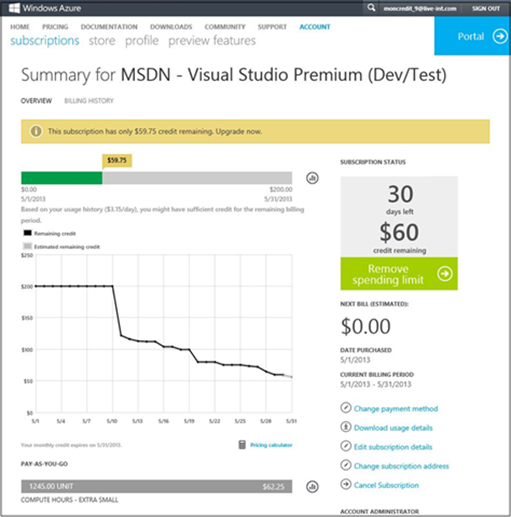Windows Azure Billing Changes, Dev/Test Scenarios, Hybrid Architectures and other enhancements
Since Windows Azure Infrastructure Services moved to general availability some weeks ago, we have been hard at work to bring some new capabilities to the market. Yesterday, during TechEd, we announced fantastic enhancements to our current service. Let me try to summarize the most important ones:
Announcing true cloud economics:
Per minute billing with no minimums
Starting June 3, 2013, Virtual Machines, Web Roles and Worker Roles are going to be billed by the minute versus being billed by the hour. SQL Server and BizTalk Server running in Virtual Machines will also be billed by the minute. And, we have no minimums unlike competition – the other cloud providers. Paying for what you use in the cloud is great; no longer being rounded to the nearest hour and no minimums -- even better.
Stop running virtual machine and stop billing
Starting June 3, 2013, when you shut down your virtual machines, the billing meters will stop as well. No need to delete stopped instances to manage compute costs. From dev and test to application hosting in Virtual Machines, cloud economics just keeps getting better for all kind of workloads. Of course you can automate this process using Windows Azure Management API, System Center 2012 SP1, or using third-party solutions like RightScale or AppDynamics. It’s also very useful to use the free service from MetricsHub to monitor and set all kind of alerts (e-mail and SMS).
Dev/Test scenarios in the cloud
MSDN software in Windows Azure
Starting June 3, 2013, we are allowing using MSDN dev/test software licenses on Windows Azure. This allows to install and use Your MSDN dev/test server images for SQL Server, SharePoint, BizTalk, etc. at no extra charge within Windows Azure virtual machines. Microsoft server software that is supported by Windows Azure Virtual Machines is listed here.
Heavily Discounted MSDN Dev/Test Rates
Starting June 3, 2013, we are also announcing a new billing rate for customers who have MSDN subscriptions. MSDN subscribers receive a 33% discount on Windows Virtual Machines, and 25% discounts on Cloud Services, HDInsight, and Reserved Websites. For example: the standard price for an Extra Large (A4) virtual machine with Windows is 0,5362 €/hour. The price for MSDN subscribers is 0,3575 €/hour (a 33% price reduction). What’s even better, the standard price for a A4 machine with SQL Server Standard is 1,3554 €/hour but with if you need it for dev/test and you have MSDN subscription, you will still pay 0,3575 €/hour. You can find additional details on the MSDN Benefits here.
MSDN Monthly monetary credits
The new Windows Azure MSDN benefit offers up to 115 € per month (40€/month for MSDN Professional Subscribers, 75€/month for MSDN Premium Subscribers and 115€/month for MSDN Ultimate Subscribers) in credits to use on any service they want for development and testing - including Virtual Machines (VMs), Web Sites, Cloud Services, Mobile Services, Storage, SQL Database, Content Delivery Network, HDInsight, Media Services, and many more. We think that this simplifies the Windows Azure MSDN benefit to a single measure of credits and increases the flexibility by enabling the use of these credits across any combination of Windows Azure services. It’s important also to understand that Windows Azure MSDN benefit is for development and test purposes only and does not carry a financially-backed SLA. Production workloads must be run on regular subscriptions.
We have also improved our portal so it’s easier to track your MSDN credit usage. Here is an example of the detailed usage page of a MSDN Azure subscription:
More options for hybrid architectures
Additional Options for Building Virtual Private Network
Starting June 3, 2013, there are even more device options in setting site to site connections with Virtual Networks: WatchGuard, F5 and Citrix virtual private network (VPN) devices in addition to Cisco, Juniper will be supported. Additionally, the recent enhancements to the ‘Site-to-Site” connectivity enables users to use Windows Server 2012 RRAS (Routing and Remote Access) as an on-premises VPN server. This gives you the flexibility of using a software based VPN solution to connect on-premises networks to Windows Azure.
Additional Security Option for Virtual Machines: Public Endpoint Access Control Lists (ACL)
We are adding an additional security option so that administrators can control inbound traffic to Virtual Machines. You simply define how traffic from outside of your corporate firewall communicates with your Virtual Machine public endpoints through PowerShell and soon it will be available in the management portal. To specify ACLs to the endpoints, you will need to download Windows Azure PowerShell cmdlets June 2013 or latest update from here. There is also a good post from Michael Washam with sample scripts and more details.
Other interesting enhancements
SSL Support with Web Sites: With yesterday’s update, Windows Azure Web Sites now support Secure Sockets Layer (SSL) for custom domains.
Windows Azure Active Directory: We now offer a free tool that enables you to securely sync your on-premises Active Directory without having to setup ADFS. If you have worked with ADFS in the past, you probably know that this will really simplify the process to enable your directory in the cloud. Yesterday’s update also includes support to manage an existing Windows Azure Active Directory (such as the one that your organization already uses with Office 365) with a Windows Azure account
New BizTalk Services: We are announcing the public preview of Windows Azure BizTalk Services, a new integration service in Windows Azure that provides robust EDI processing and cloud application integration. BizTalk Services allows you to easily integrate your Windows Azure, SaaS, B2B, and on-premises applications though a configuration-driven experience. You can sign up for the Preview here.
If you want more information about all these new announcements, I strongly suggest you reading these posts:
- Faster development, global scale, unmatched economics… Windows Azure delivers.
- Windows Azure: Announcing New Dev/Test Offering, BizTalk Services, SSL Support with Web Sites, AD Improvements, Per Minute Billing
Hope this helps.
